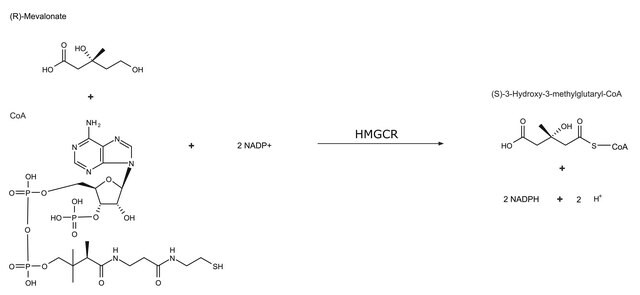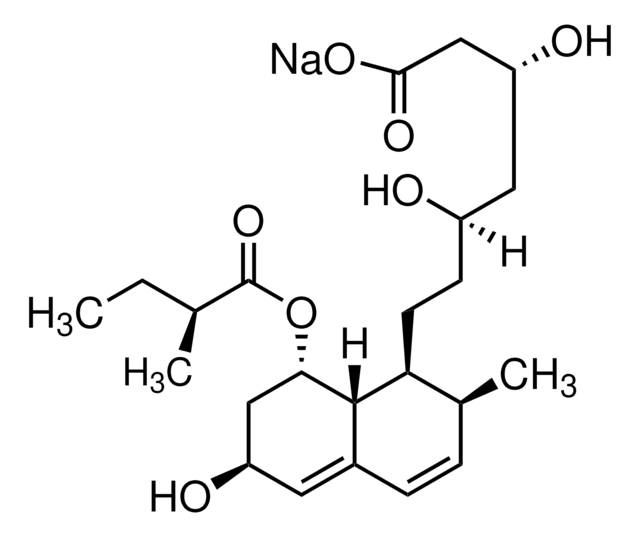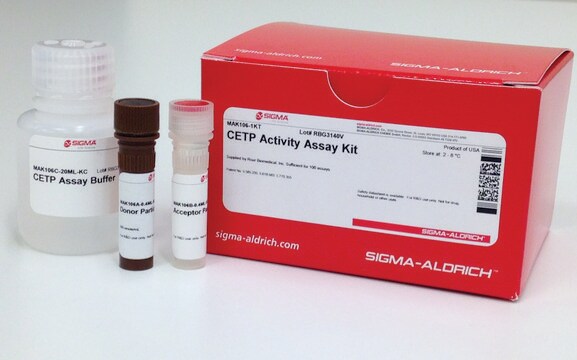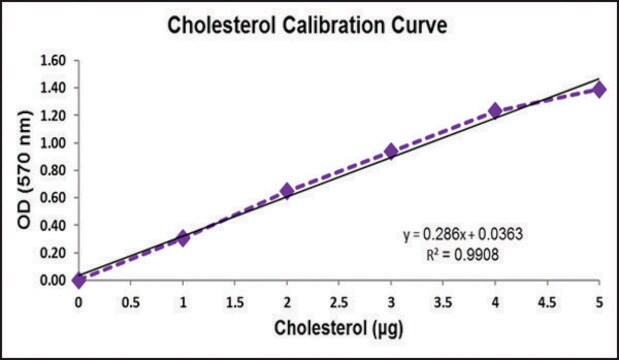CS1090
HMG-CoA Reductase Assay Kit
sufficient for 30 assays (1 mL), sufficient for 100 assays (200 μL)
Sinónimos:
HMGR Assay Kit
Iniciar sesiónpara Ver la Fijación de precios por contrato y de la organización
About This Item
UNSPSC Code:
12161503
NACRES:
NA.28
Productos recomendados
usage
sufficient for 100 assays (200 μL)
sufficient for 30 assays (1 mL)
Quality Level
shipped in
dry ice
storage temp.
−70°C
Gene Information
human ... HMGCR(3156)
Categorías relacionadas
General description
The HMG-CoA Reductase Assay Kit is an important tool for the basic research of cholesterol and other related metabolic pathways.
Application
The HMGR activity kit is designed for the detection of HMG-CoA reductase activity. A major function of the kit is to screen for various inhibitors and activators of the purified catalytic subunit of the enzyme, HMG-CoA reductase, which may play a crucial role in therapeutics. The assay is based on the spectrophotometric measurement of the decrease in absorbance at 340 nm, which represents the oxidation of NADPH by the catalytic subunit of HMGR in the presence of the substrate HMG-CoA.
Biochem/physiol Actions
HMGR (3-hydroxy-3-methylglutaryl-CoA reductase) is a transmembrane glycoprotein located on the endoplasmic reticulum. This enzyme catalyzes the four-electron reduction of HMG-CoA to coenzyme A (CoA) and mevalonate, which is the rate-limiting step in sterol biosynthesis. The activity of HMGR is controlled through synthesis, degradation, and phosphorylation in order to maintain the concentration of mevalonate derived products. In addition to the physiological regulation of HMGR, the human enzyme has been targeted successfully by drugs in the clinical treatment of high serum cholesterol levels. Controlling serum cholesterol levels has an important therapeutic role since hypercholesterolemia often leads to the development of atherosclerosis and subsequently to cardiovascular pathologies, which might result in myocardial infarction and stroke. It has been suggested that a disturbance of cholesterol homeostasis contributes to the development of a chronic inflammatory state.
Los componentes del kit también están disponibles por separado
Referencia del producto
Descripción
SDS
- N6505β-Nicotinamide adenine dinucleotide 2′-phosphate reduced tetrasodium salt hydrate, ≥95% (HPLC) 25 mgSDS
Storage Class
11 - Combustible Solids
Elija entre una de las versiones más recientes:
¿Ya tiene este producto?
Encuentre la documentación para los productos que ha comprado recientemente en la Biblioteca de documentos.
Los clientes también vieron
G A Holdgate et al.
Biochemical Society transactions, 31(Pt 3), 528-531 (2003-05-30)
The statins are inhibitors of 3-hydroxy-3-methylglutaryl CoA (HMG-CoA) reductase (HMG-CoAR), and are utilized to decrease levels of atherogenic lipoproteins in patients with, or who are at high risk of, cardiovascular disease. This study describes the inhibition of a recombinant, catalytic
A J Koning et al.
Molecular biology of the cell, 7(5), 769-789 (1996-05-01)
In all eucaryotic cell types analyzed, proliferations of the endoplasmic reticulum (ER) can be induced by increasing the levels of certain integral ER proteins. One of the best characterized of these proteins is HMG-CoA reductase, which catalyzes the rate-limiting step
Matteo Mozzicafreddo et al.
Journal of lipid research, 51(8), 2460-2463 (2010-04-27)
Radioisotope-based and mass spectrometry coupled to chromatographic techniques are the conventional methods for monitoring HMG-CoA reductase (HMGR) activity. Irrespective of offering adequate sensitivity, these methods are often cumbersome and time-consuming, requiring the handling of radiolabeled chemicals or elaborate ad-hoc derivatizing
E S Istvan et al.
Biochimica et biophysica acta, 1529(1-3), 9-18 (2000-12-09)
In higher plants, fungi, and animals isoprenoids are derived from the mevalonate pathway. The carboxylic acid mevalonate is formed from acetyl-CoA and acetoacetyl-CoA via the intermediate 3-hydroxy-3-methylglutaryl coenzyme A (HMG-CoA). The four-electron reduction of HMG-CoA to mevalonate, which utilizes two
Rosana Aparecida Manólio Soares et al.
International journal of molecular sciences, 16(2), 4150-4160 (2015-02-19)
The objective of this study was to identify the major peptides generated by the in vitro hydrolysis of Amaranthus cruentus protein and to verify the effect of these peptides on the activity of 3-hydroxy-3-methyl-glutaryl-CoA reductase (HMG-CoA reductase), a key enzyme
Artículos
HMG-CoA Reductase (HMGR) Assay Kit
Nuestro equipo de científicos tiene experiencia en todas las áreas de investigación: Ciencias de la vida, Ciencia de los materiales, Síntesis química, Cromatografía, Analítica y muchas otras.
Póngase en contacto con el Servicio técnico













